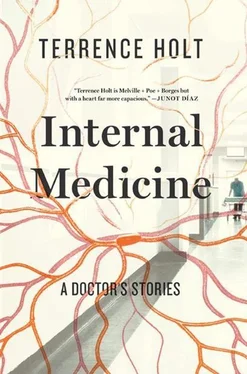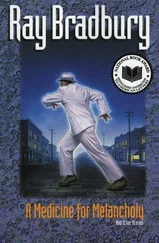The team consists of eight or nine people: respiratory techs, anesthesiologists, pharmacists, and the residents on call for the cardiac ICU. On hearing the summons, the residents drop whatever they are doing and sprint. People running full-tilt in a hospital is unavoidably a spectacle. In their voluminous white coats, from whose pockets fall stethoscopes, penlights, reflex hammers, EKG calipers, tuning forks, ballpoint pens (these clatter across the floors, to be scooped up by the medical student who follows behind), the medical team’s passing is a curious combination of high drama and burlesque.
The medical team arrives on a scene of Bedlam. The room is so crowded with nurses, CNAs, janitors, and miscellaneous onlookers that it can be physically impossible to enter. Shouldering your way through the mob at the door, you are stopped by a crowd around the bed; the crash cart, a rolling red metal Sears Roebuck toolchest, is also in the way, its open drawers a menace to knees and elbows. There are wires draped from the crash cart, and tubing everywhere.
At the center of all this lies the patient, the only one in the room who isn’t shouting. She doesn’t move at all. This time it is an elderly woman, frail to the point of wasting; her ribs arch above her hollow belly. Her eyes are half open, her jaw is slack, pink tongue protruding slightly. Her gown and the bedding are tangled in a mass at the foot of the bed; at a glance you take in the old mastectomy scar, the scaphoid abdomen, the gray tuft between her legs. At the head of the bed, a nurse is pressing a mask over her face, squeezing oxygen through a large bag; the woman’s cheeks puff out with each squeeze, which isn’t right. Another nurse is compressing the chest, not hard enough. You shoulder her aside and press two fingers under the angle of the jaw. Nothing. A quick listen at her chest: only the hubbub in the room, dulled by silent flesh. Pile the heels of both hands over her breastbone and start to push: the bed rolls away. Falling half onto the patient, you holler above the commotion, “Somebody please lock the bed.” Alternate this with, “Does anyone have the chart?”
A nurse near the door hoists a thick brown binder, passing it over the heads jamming the room. “Code status,” you bawl out. “Full code,” the nurse bawls back. You reposition your hands and push down on her breastbone. “Why’s she here?” There is a palpable crunch as her ribs separate from her sternum. “Metastatic breast cancer,” the nurse calls, flipping pages in the chart. “Admitted for pain control.” You lighten up the pressure and continue to push, rhythmically, fast. You look around, trying to pick out from the mass of excited bystanders the people who belong; the background is a weird frieze of faces and limbs reaching, pointing, gesticulating, mouths open. The noise is immense. On the opposite side of the bed you see one of the respiratory techs has arrived. “Airway,” you shout, and the tech nods: she has already seen the puffing cheeks. She takes the mask and bag from the nurse and adjusts the patient’s neck. The patient’s chest starts to rise and fall beneath your hands.
“What’s she getting for pain?”
“Morphine PCA.”
“What rate?”
The question sets off a flurry of activity among some nurses, one of whom stoops to examine the IV pump at the patient’s bedside. “Two per hour, one q fifteen on the lockout.”
“Narcan,” you order.
By this time the pharmacist has arrived, which is fortunate because you can’t remember the dose of opiate-blocker. You doubt this is overdose here, but it’s the first thing to try. Out of the corner of your eye you see the pharmacist load a clear ampule into a syringe and pass it to a nurse.
Meanwhile, on your left, the other resident and the intern are plunging large needles into both groins, probing for the femoral vein. The intern strikes blood first, removes the syringe, throws it onto the sheets. “Send that off for labs,” you shout. Blood dribbles from the needle’s hub as the intern threads a long, coiled wire through it into the vein. The other resident stops jabbing and watches the intern’s progress. With a free hand she feels for the femoral pulse, but the bed is bouncing. You stop compressing. The resident focuses, shakes her head. Start compressing again.
A nurse reaches around you on the right, trying to fit a pair of metallic adhesive pads onto the patient’s chest. You shake your head. “Paddles,” you shout. “Get me the paddles.” Then, into the general roar, “Somebody take that syringe and send it off for labs.” A hand grabs the syringe and whisks it off. “You,” you shout at the med student, who is hanging by the resident’s elbow. “Get a gas.” The resident throws a package from the crash cart, then steps back to give the student access to the patient’s groin. The student fits the needle — it’s a sixteen-guage, two inches long — to the blood gas syringe, feels for the pulse your compressions are making in the groin, and stabs it home: blood, dark purple, fills the barrel. The student looks worried; he may have missed the artery. It doesn’t matter. The student passes it around the foot of the bed to another hand and it vanishes.
The nurse at your elbow is still there, holding the defibrillator paddles. She stands as though she has been holding these out to you for some time. Clap the paddles on the patient’s chest. Over your shoulder on the tiny screen of the defibrillator a wavy line of green light scrawls horizontally onward. You look back at the other resident. “Anything?” you both say at once, and both of you shake your heads. The intern has finished with the femoral catheter, very fast. He holds up one of the access ports. “Amp of epi,” you say, but there’s no response. Louder: “I need an amp of epi.” Finally someone shoves a big blunt-nosed syringe into your hand. Without stopping to verify that it’s what you asked for, you lean over and fit it to the port and push the plunger. Another look at the screen. Still nothing. “Atropine,” you call out, and this time a nurse has it ready. “Push it,” you say, and she does. Stop compressions, check the screen.
Suddenly the wavery tracing leaps into life, a jagged irregular line, teeth of a painful saw. “V fib,” the other resident calls out, annoying you for a moment. You clamp the paddles down on the patient’s ribs. “Everyone clear?” Everyone has moved back two feet from the bed. You check your own legs, arch your back: “Clear?” You push the button. The patient spasms, then lies limp again. The pattern on the screen is unchanged. The other resident shakes her head. You call over your shoulder, “Three hundred,” and shock again. The body twitches again. An unpleasant smell rises from the bed.
The pattern on the screen subsides, back to the long lazy wave. Still no pulse. You start compressing again. “Epi,” you call out. “Atropine.” There is another flutter of activity on the screen, but before you can shock, it goes flat again, almost flat, perhaps there is a suggestion of a ragged rhythm there, fine sawteeth. “Clear,” you call again, and everybody draws back. “Three-sixty,” you remember to say over your shoulder, and when the answering call comes back you shock again, knowing this is futile. But the patient is dead and there is no harm in trying. As the body slumps again, there is a palpable slackening of the noise level in the room, and even though you go on another ten minutes, pushing on the chest until your shoulders are burning and your breath is short, and a total of ten milligrams of epinephrine have gone in, there is nothing more on the monitor that looks remotely shockable.
Finally, you straighten up, and find the clock on the wall. “I’m calling it,” you say. Against the wall, a nurse with a clipboard makes a note. “Time?” she says. You tell her.
Читать дальше












